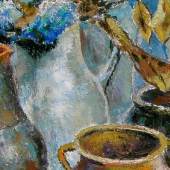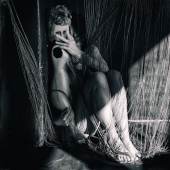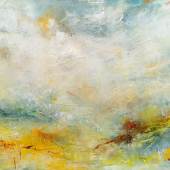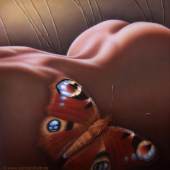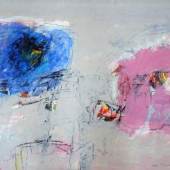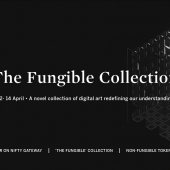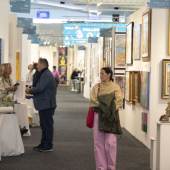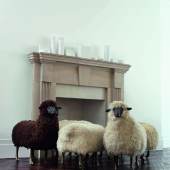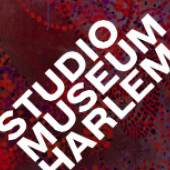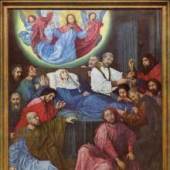Ed Ruscha’s Standard Station, Ten-Cent Western Being Torn in Half
-
Auktion19.11.2024
Starting with tempera and ink-and-paper studies, Ruscha mapped out a design that boldly split the canvas on a diagonal, from upper left to lower right, as he had done previously with his Large Trademark with Eight Spotlights (depicting the 20th Century Fox logo), a work shown at his 1963 Ferus show, suggesting, as Ruscha himself would later observe, that he saw the Standard station as another kind of ‘trademark’.
He also included spotlights in the new painting (three, winnowed down from seven in early studies), which reversed the orientation of the Amarillo photograph and showed the Standard station from a vantage point that seemed to be practically below the paved surface of Northeast Eighth Avenue. The steep angle, exaggerated perspective, and vaulting diagonals evoked the time-tested Hollywood filmmakers’ trick of shooting an approaching train from a low angle: Ruscha thus brought surging velocity to this still image, a manoeuvre he would continue to employ in future paintings.
There was another, improbable influence behind the stunning composition that became known as Standard Station, Amarillo, Texas. Ruscha has also claimed that he modeled the Standard station “after the way Bambi’s father stood in the forest.” This, in turn, reminded him of the stately buck used as a corporate symbol by the Hartford Insurance Company, where his father (who died in 1959) had worked. The autobiographical dimensions of Ruscha’s Standard station imagery have rarely been probed.
If the original black-and-white photograph had been pointedly boring, the resulting painting — reds and whites with an infinite inky sky and three probing yellow spotlights, all stretched across five-and-a-half by ten feet of canvas — was over-the-top drama. Ruscha had imbued a banal specimen of roadway architecture with jaw-dropping beauty and thunderous monumentality. ‘It has to be called an icon,’ Ruscha later said. ‘It sort of aggrandizes itself before your eyes. That was the intention of it, although the origins were comic.’
Having never intended to make a gas-station painting, Ruscha now decided to make another one. For this iteration, the same size as the first, he would show the Standard station in daylight.
****
ON STANDARD STATION, TEN CENT WESTERN BEING TORN IN HALF, 1963
Standard Station, Amarillo, Texas (Day) was perhaps an early title, as Ruscha kept the layout he used for the first painting but dispensed with the night sky and replaced it with a bright blue that, for all its stylization, is pretty much an exact match for a clear afternoon sky on the Great Plains. For obvious reasons, the yellow spotlights are now gone. As in the first painting, there are five red Chevron pumps (close inspection reveals their make and model to be Wayne 505s) in the same two-three configuration. (The totals on the pumps — $2.27, $4,21 — remind us that we’re looking at the early 1960s.)
But, because we’re now seeing the service station in daylight, there are deeper shadows, cool blue ones, under the canopy; the first painting had shown this area illuminated by fluorescent tube lighting, drenching everything in shadowless, artificial white. In the original Standard station painting Ruscha left in some perspective lines, displaying draftsman-like underpinnings; in the second version they have been expunged.
A wholly novel element differentiates the new painting: a pulp magazine hovering near the top-right corner that determined the title Ruscha ultimately gave the piece: Standard Station, Ten-Cent Western Being Torn in Half. The dime Western in question, ripped and spindled, is the October 1946 issue of Popular Western, which Ruscha had included in his Noise, Pencil, Broken Pencil, Cheap Western, executed in the spring of 1963.
In the Standard station painting, the mutilated magazine appears to sit, trompe l’oeil style, on the flat, pristine surface. In one of his studies, Ruscha had placed a cocktail olive there instead of the magazine. Ruscha later described this impulse toward such visual non-sequiturs: ‘Often, when an idea is so overwhelming I use a small unlike item to ‘‘nag’’ the theme.’ He has also compared this antagonistic, ‘unlike’ element to the coda on a piece of music. In adding Popular Western, Ruscha also slyly brought a human figure into the composition, as the cover shows a Texas Ranger who has just shot a bank robber. ‘So I was painting a painting of a painting’, the artist said.
Ruscha’s twin Standard station paintings hinted at the seriality Warhol had explored in his Campbell’s soup can paintings. As in other Ruscha works there was an emphasis on a word —‘STANDARD’ — but now the word was part of a landscape. There have been inflated interpretations attempting to read ‘standard’ as a commentary about standardization or ordinariness, but Ruscha has always shot them down, suggesting that any buried meanings are in the eyes of the beholder.
****
-
12.04.2021 - 14.04.2021By Pak • 12- 14 April • A novel collection of digital art redefining our understanding...
-
20.04.2022ARTEXPO NEW YORK CELEBRATES ITS 45TH ANNUAL EDITION WITH A RENAISSANCE IN CONTEMPORARY AND FINE...
-
23.05.2018NEW YORK, 16 May 2018 – Today, Sotheby’s is honored to unveil the full contents of A...
-
Er gilt als der größte niederländische Maler "Hugo van der Goes" im sp...
-
19.11.2024Auktion »
Exhibition
18 March – 17 May, 10am – 6pm
Closed on Saturdays, Sundays, and Public HolidaysLocation
Unit L20C, 20th Floor, Gaysorn Tower
127 Ratchadamri Road, Lumpini, Patumwan, Bangkok
10330
